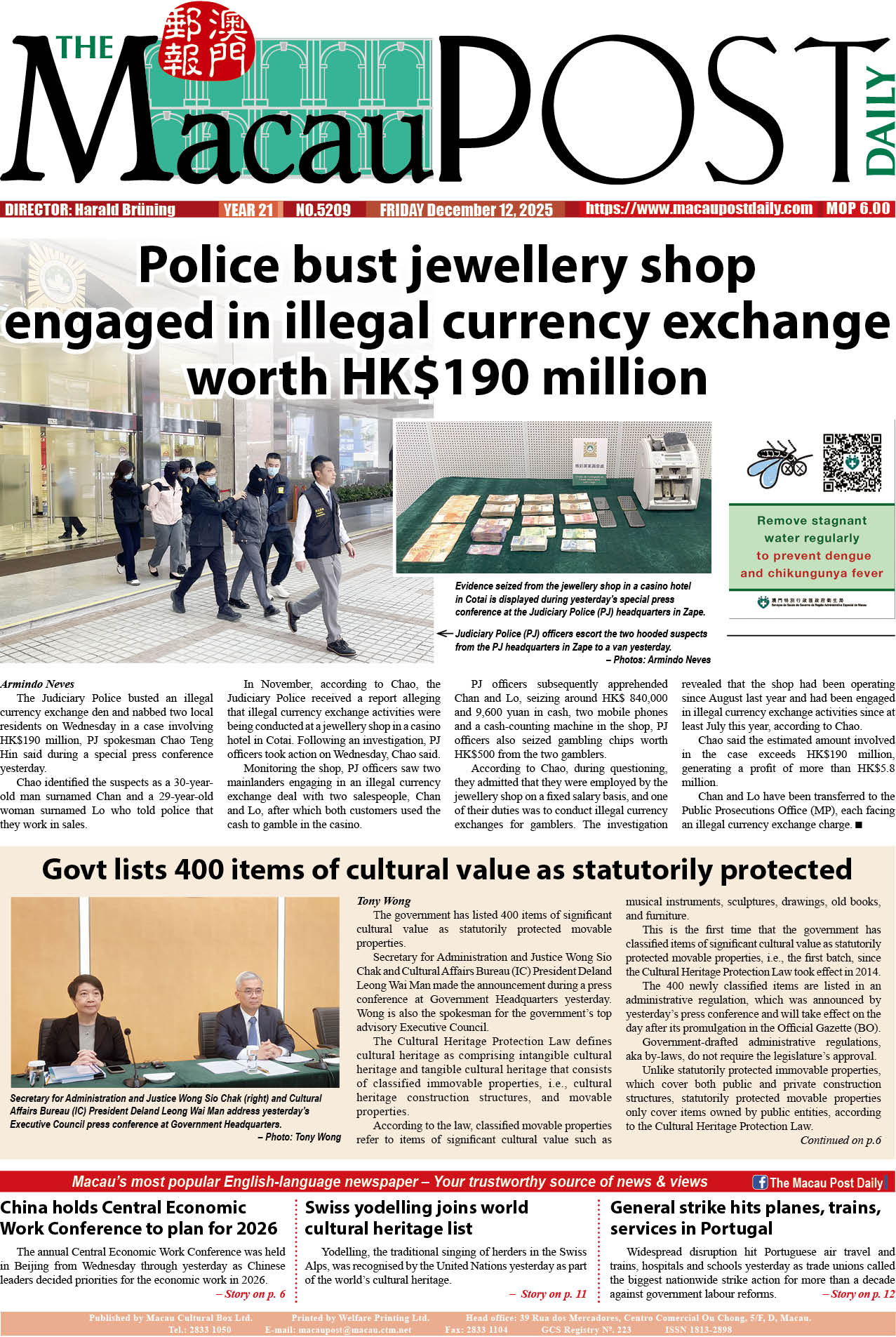Addressing yesterday’s regular press conference about Macau’s novel coronavirus (COVID-19) situation, Macau Government Tourism Office (MGTO) Deputy Director Cheng Wai Tong announced that the office will add 10 new itineraries from tomorrow to its ongoing subsidised programme for residents joining tour groups organised by travel agencies to tour the city, with one of them featuring helicopter rides for which each resident will have to fork out 398 patacas of his or her own money – on top of the government’s 280-pataca subsidy.
The other nine new itineraries, for which each resident will have to pay between 18 patacas and 108 patacas – on top of the 280-pataca subsidy, will include visits to the Light Rail Transit (LRT) depot in Cotai, private jets parked at the airport, and the State Key Laboratory of Lunar and Planetary Sciences at the private Macau University of Science and Technology (MUST) in Taipa.
Cheng also said that if a resident has already joined two groups under the programme with the government’s total subsidy of 560 patacas, they will not able to benefit from any additional subsidy if they join any of the tours under the 10 new itineraries – i.e. they will need to pay the full price.
The office launched the programme, officially known as “Macao Ready Go! Local Tours” in English, on June 22, initially comprising 15 itineraries in two categories, namely “Community-based Tours” (six itineraries) and “Leisure Tours” (nine itineraries). The programme, which will run until September 30, aims to help the local tourism industry which has been hit hard by the COVID-19 pandemic.
With the addition of the 10 new itineraries, the programme will comprise 25 itineraries in total from tomorrow.
Under the programme, each Macau resident – both permanent and non-permanent residents – will receive a subsidy of 280 patacas from the government’s Macau Foundation (FM) each time they join a tour group. They can receive a subsidy of up to 560 patacas for the programme so that they can join the programme twice thanks to the government’s subsidy.
On top of the 280-pataca subsidy, each resident has to pay between 18 patacas and 138 patacas to join one of the 15 original itineraries, which include visits to cultural heritage sites, CEM’s power station in Coloane, the Air Macau operations centre, entertainment facilities in the resorts of the six gaming operators, as well as sightseeing boat trips in Macau’s coastal waters, and experiencing a LRT ride in Taipa and Cotai.
Residents can choose to join a tour group under either the “Community-based Tours” or “Leisure Tours” category for their first participation in the programme, after which they will have to choose to join a tour group under the other category. After their two participations in the programme with the 560-pataca subsidy, residents can still join other tour groups in the programme, but they will need to pay the full price. Non-locals can also join the programmes but will not be able to benefit from the government’s 560-pataca subsidy.
During yesterday’s press conference, Cheng said that the 10 new itineraries of the programme’s “second phase” will start tomorrow, when residents can start to register with local travel agencies which have joined the programme. The 10 new itineraries consist of seven “Community-based Tours” and three “Leisure Tours”.
According to the programme’s official brochure, residents joining the 398-pataca itinerary featuring a helicopter ride will take off from the Outer Harbour Ferry Terminal. The helicopter will fly over the Hong Kong-Zhuhai-Macau Bridge (HZMB) and the University of Macau (UM) campus on Hengqin Island. The itinerary, the most expensive one among the 25 itineraries, will also include vistis to Macau Tower and the Light Night Market at Macau Fisherman’s Wharf. The helicopter tour groups will be organised every Friday, Saturday and Sunday.
LRT depot, private jet
According to the brochure, the itinerary featuring a visit to the LRT depot, for which each resident will have to pay 38 patacas, will also include a visit to Le Garden at The Parisian Macao in Cotai, while the itinerary featuring a visit to the MUST State Key Laboratory of Lunar and Planetary Sciences, for which each resident will have to pay 108 patacas, will also include visits to various other facilities at the university and also The Parisian Macao’s Le Garden. Residents joining the itinerary featuring a visit to the cabin of a private jet, which costs 68 patacas, will also visit the Hac Sá Reservoir Natural Park in Coloane and its adjacent “sunflower field”.
Cheng said that MGTO decided to launch the 10 new itineraries to make the programme more attractive.
Meanwhile, Cheng noted that 87,261 people (about 12 percent of the population) have joined the programme since its launch last month, adding that 34 percent of them have joined the tour groups under the “Community-based Tours” category while the remaining 66 percent have joined the tour groups under the “Leisure Tours” category.
Cheng pointed out that the office has been constantly surveying the participants’ opinions on the programme. According to the findings of the survey, 85 percent of the respondents said that they were satisfied with the itineraries, while 88 percent of them said that they were satisfied with the tour guides’ performances, and 92 percent said that they were satisfied with the coach drivers’ services, Cheng said.
Cheng also revealed that initially after the programme was launched, some residents who had joined the tour groups complained that they knew more about the UNESCO-inscribed Historic Centre of Macau sites than the tour guides.
Meanwhile, Alvis Lo Iek Long, a clinical director of the public Conde de São Januário Hospital Centre, announced during yesterday’s press conference that casino frontline workers who have undergone their one-off nucleic acid tests (NAT) arranged by the Health Bureau (SSM) will now have their test results displayed on their Macau Health Code, allowing them to cross the Macau-Zhuhai border.
NATs for casino staff
The Health Bureau started to carry out one-off nucleic acid tests (NATs) for casino frontline workers – including dealers, cage workers and security guards – last Thursday.
Macau-Zhuhai cross-border commuters have to present a valid NAT certificate confirming that they have tested negative for COVID-19 within the past seven days – which is displayed on their Macau Health Code when entering Macau and on their Guangdong Health Code when entering Zhuhai.
Lo pointed out that the Health Bureau decided that the casino workers’ NAT results were not displayed on their Macau Health Code previously with the aim of preventing large crowds at the Macau-Zhuhai border checkpoints as residents were still not familiar with converting their Macau Health Code into a Guangdong Health Code at that time. Lo said that the residents have now become more familiar with the conversion of the two health codes so that the Health Bureau has decided to roll out the new arrangement.
Lo also said that the Health Bureau tested about 4,000 casino frontline workers for COVID-19 per day from last Thursday to Saturday – 12,000 workers in total already tested.
Meanwhile, Lo also announced that a new testing station for the local government’s NAT scheme, which is located at the Macau Forum complex in Zape, will come into operation today, with the aim of diverting the flow of people from the programme’s main testing station at the Taipa Ferry Terminal in Pac On.
Lo said that four groups of local residents – senior citizens aged at least 65, minors aged below 18, people with disabilities, and those suffering from “special diseases” (namely infectious diseases, drug addiction, tumours and psychiatric diseases) – can also choose to undergo their nucleic acid tests at the Macau Forum testing station, in addition to choosing to undergo the tests at the programme’s main testing station in Pac On. Other Macau residents will still have to undergo their tests at Pac On after making an appointment.
19th ‘government facemasks’ round
Meanwhile, the 19th round of the government’s facemask purchase scheme will start today. The facemasks sold under the scheme are colloquially known as “government facemasks”.
Under the facemask purchase scheme, which was launched by the government on January 23, each local resident and non-resident worker is entitled to buy 10 facemasks at the fixed price of eight patacas every 10 days at designated outlets upon presentation of their original Macau ID card or work permit (informally known as a “blue card”). In each round, which lasts 10 days, parents or legal guardians are entitled to buy 10 facemasks for each child aged between five and eight, and five facemasks for each kid aged between three and four.

Macau Government Tourism Office (MGTO) Deputy Director Cheng Wai Tong addresses yesterday’s press conference at the Health Bureau (SSM) about the city’s novel coronavirus (COVID-19) situation. Photo: GCS







